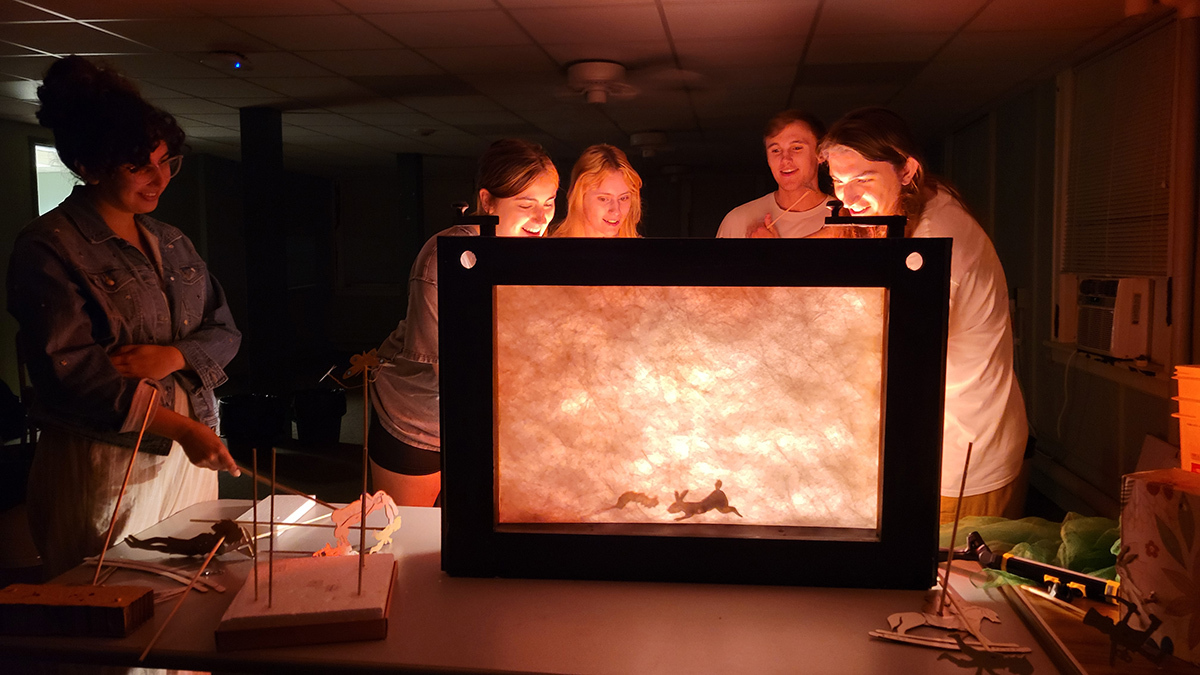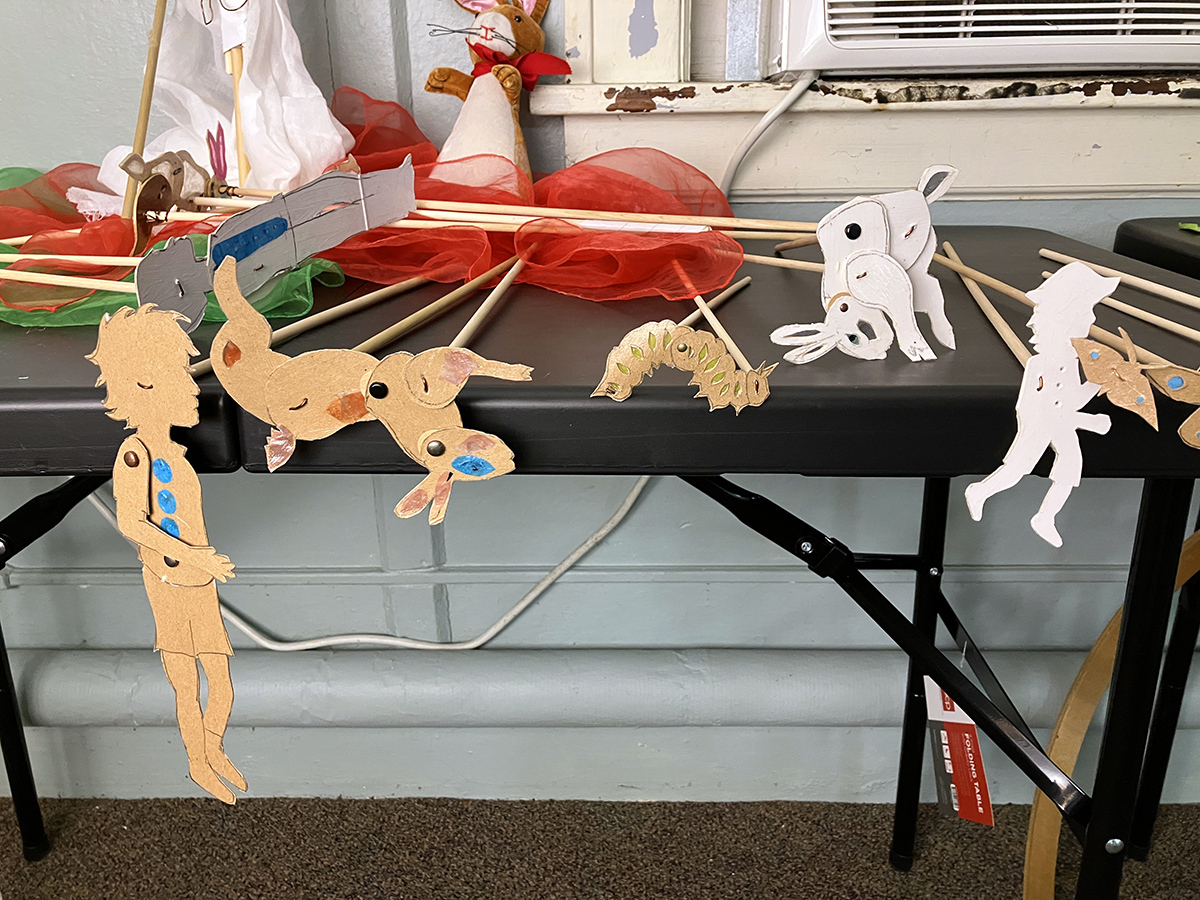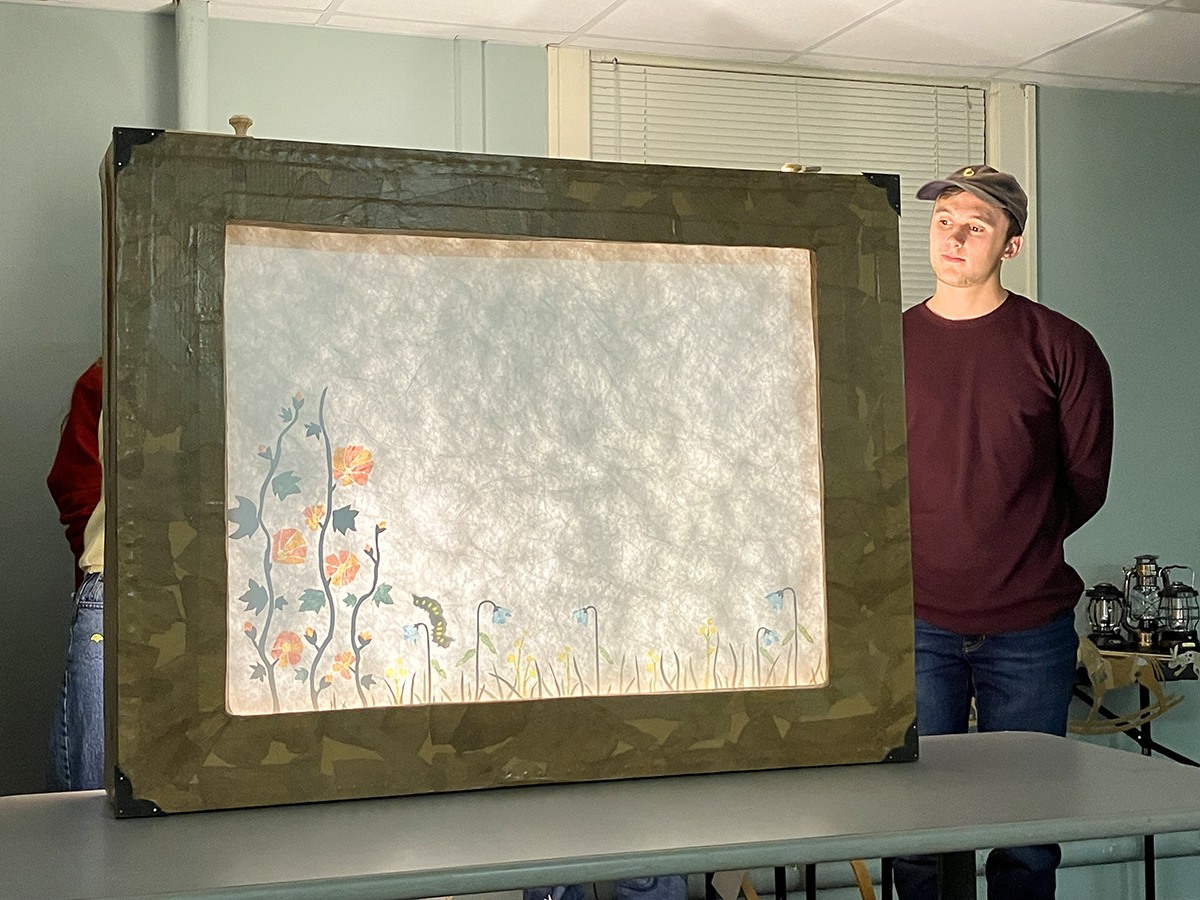
From left: Yvonne Farah, Chris Aukes, Katie Ammerman, Max Quanrud and Michael McAuliff practice shadow puppetry with a scrolling crankie backdrop. Larger image. Credit: Music and Theatre Deptartment/Iowa State University.
AMES, Iowa — In the puppet lab at Iowa State University, students sit cross legged on the carpet, reviewing their lines before rehearsal. Behind them, propped on a table, is something that looks like a giant TV made of paper.
It’s a “crankie” or “moving panorama,” explains Nicole Bennett-Tuel, a senior in performing arts. Turning a handle on the top of the frame slides a large sheet of paper across the front, revealing different scenes — a closet full of toys in one, a blooming meadow in another. They create whimsical backdrops for a collection of shadow puppets that will soon be brought to life in “The Velveteen Rabbit.”
Amanda Petefish-Schrag, associate professor of theatre, adapted Margery William’s classic children’s book for a puppet production with her husband, Ben Schrag. Originally published in 1922 after a global pandemic and during massive political and societal changes, the story of a stuffed rabbit that yearns to be real is a microcosm of loss and renewal.
“My parents read it to me when I was young, and it’s continually come back into my orbit throughout my life. Several years ago, my husband had brought it up as a possible adaptation, particularly in thinking about puppets. We both were really intrigued by how shadow puppets could be used to investigate some of the central themes and questions about what is ‘real’ and what it means to become fully real,” says Petefish-Schrag.

A collection of shadow puppets for “The Velveteen Rabbit.” Larger image. Credit: Iowa State University.
Shadows hint at the objects that cast them, she explains. But they are fleeting and easily manipulated, as anyone who has contorted their hands in front of a lamp can confirm.
“Shadows are an interesting juxtaposition of something that, in some ways, is far removed from reality while also fundamental – almost primal – in our understanding of ourselves and the world,” says Petefish-Schrag.
After writing a script, Petefish-Schrag built the crankie and around 30 shadow puppets, almost entirely from paper, while Ben Schrag composed and recorded original music. Bennett-Tuel, the production’s assistant director and community outreach coordinator, contacted local businesses, nonprofits and public libraries to line up a performance tour in Ames and Nevada. Running from Nov. 29 to Dec. 9, “The Velveteen Rabbit” is free and open to the public (see side bar.)
“This show will appeal to kids, but I have no doubt that adults will get a lot out of it that they wouldn’t expect. It feels relevant. As a mom, I’ve read this story, but watching this stage adaptation hits differently every time,” says Bennett-Tuel.
Back in the puppet lab, Chris Aukes, a sophomore minoring in performing arts and majoring in human development and family studies and women’s and gender studies, picks up one of the rabbit shadow puppets. It jumps and nods its head, all with subtle twists of wooden dowels. Aukes says the themes in the show and the opportunity to perform in small venues in the community were a big draw when auditioning.
“And of course, I love the directors. Amanda and Nicole are wonderful to work with,” Aukes adds.

Max Quanrud, a sophomore in biochemistry and part of the ensemble cast for “The Velveteen Rabbit,” stands next to the crankie during a rehearsal. Larger image. Credit: Iowa State University.
The students in the ensemble say this is the first time they’ve performed with puppets. Many were interested in trying something new. Michael McAuliff, a freshman in history and education, describes it as a “breath of fresh air” and a chance to “dip [his] toes in the water.”
After a series of neck and arm stretches, the five-member cast begins its run-through of “The Velveteen Rabbit.” They take turns narrating — sometimes in unison — in front of the crankie as characters emerge. A peek behind reveals a well-choreographed dance. Arms weave through a tight space to pick up shadow puppets, turn the crankie and switch lights on and off.
In one of the scenes, the little boy is sick in bed with the velveteen rabbit. Yvonne Farah, a graduate student in industrial engineering, waves a red piece of cloth over the lamp that lights up the crankie. From the front, the subtle blush that fades in and out, emulates a high fever.
Through light and shadow, layers of paper and deliberate introductions of color, the show invites viewers into a liminal space between the real and imagined.




